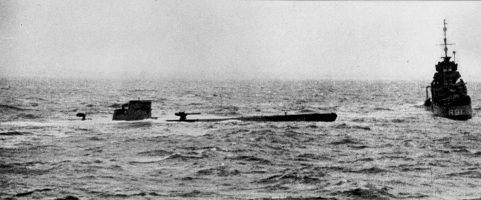What happened to Fritz-Julius Lemp?
On April 15, 1941, Kapitänleutnant Fritz-Julius Lemp left the German submarine base in Lorient, France, in command of U-110. It was Lemp’s second patrol in his new boat (see blog post “Fritz-Julius Lemp, Part 6,” Aug. 1, 2016). His first patrol had ended two weeks earlier without sinking a single ship.
Twelve days into his patrol, Lemp sank a small British freighter and received word a few days later of an allied convoy bound for Canada. No doubt thinking his luck had changed for the better, he rendezvoused with a second submarine the morning of May 9, ahead of the oncoming ships.
A full moon made the usual U-boat tactic of a nighttime surface attack more risky, and delaying the attack for more favorable conditions risked losing contact with the convoy. The two commanders agreed to make a submerged attack as soon as possible. As senior officer, the aggressive Lemp chose to attack first.
He was surprised to see an unusually large number of escorts accompanying the convoy but decided to attack anyway. After the escorts passed and the convoy was directly above, he came up to periscope depth, picked out his targets and fired four torpedoes. Two shots hit and sank two British cargo ships. The third torpedo damaged but didn’t sink its target and the fourth misfired.
Lemp’s crew readjusted the misfire, which had never left its tube, and he coolly prepared to attack his fourth target again. But U-110 had stayed at periscope depth too long. Three of the escorts, including the group flagship, H.M.S. Bulldog, detected the submarine and attacked.
The escorts’ depth-charges knocked out U-110’s electric motors and rudder. The boat’s stern took on water and started to sink. Leaks in the forward battery compartment began to generate chlorine gas. Amazingly, the submarine somehow surfaced on its own, possibly because a high-pressure air line had been ruptured and filled U-110’s tanks with air.
From the bridge atop the boat’s conning tower Lemp saw Bulldog and two other ships bearing down on him, intending to ram his boat. He ordered everyone to abandon ship immediately. With no time to set demolition charges, Lemp called for all vents to be opened to scuttle the boat.
Once in the water with his crew, Lemp realized U-110 wasn’t sinking. Coming to the same realization, the escort group commander aboard Bulldog called off the attack in favor of capturing the abandoned U-boat. If the British boarded his boat, Lemp knew they would recover the secret Enigma communications device and its code books, left behind on the sub in the crew’s haste to escape.
With an armed boarding party from Bulldog on its way to U-110, Lemp was seen attempting to swim back to the boat, apparently intending to open the valves. But before he could reach the submarine, Lemp mysteriously disappeared. Some German crewmen claimed he was shot by the boarding party as he swam for the submarine, a claim the British denied. Other crew members said they saw Lemp throw up his arms and sink below the surface, an apparent suicide.
It was an uncertain end to a storied naval career bookended by two monumental mistakes: sinking the passenger ship Athenia and allowing the Royal Navy to capture the Enigma machine, a major intelligence coup for the British.
Read more about Lemp Part 6


